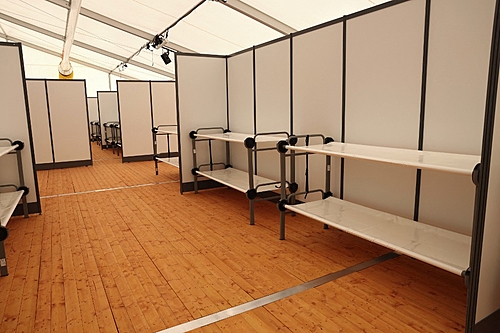
It is a cycle that does not close. Repeatedly, German municipalities ask for help as they have little or no space to accommodate more asylum seekers and war refugees from Ukraine.
The most recent example is the district of Fulda in the German state of Hessen. Cities and towns are “absolutely at the limit of their capacity” to accommodate people “with a modicum of decency”, according to a letter to the state and federal governments, approved by a large majority by the local parliament in mid-July.
“We need a limit on immigration,” said district chief Bernd Woide of the Christian Democratic Union (CDU) party, the acronym of former Chancellor Angela Merkel.
“There is not only a lack of accommodation options, but also limited capacities in childcare, schools, health care and in many other areas,” he said.
Around 300,000 applicants in 2023
Although only a few Ukrainians come to Germany, the number of asylum seekers continues to rise. The Federal Office for Migration and Refugees counted more than 162,000 asylum applications from January to June 2023.
Most people come from Syria (about 44,000), followed by Afghanistan (about 28,000) and Turkey (about 19,000). In addition, around 20,000 refugees from African countries have applied for asylum in Germany this year.
By the end of the year, there should be around 300,000 asylum seekers, believes Boris Kühn, from the research group on migration policy at the University of Hildesheim.
These applicants are distributed across Germany according to certain criteria, given accommodation and required to stay in the same location. The problem is that most accommodations are constantly occupied and often there are simply no more places.
“Crisis of Change”
Boris Kühn and Julian Schlicht, coordinator of Hilfen für Geflüchtete (Help for Refugees) in Tübingen, are authors of a survey on the housing situation of refugees in Germany. According to them, there is a “crisis of change” in the country. Currently, 25% of people who came to Germany in the migration wave of 2015 and 2016 are still living in refugee accommodation.
It is a kind of “congestion in the host system”. Especially in areas with a tight housing market, it is very difficult for recognized refugees to find an apartment to live in on their own.
For newly arrived asylum seekers, this often means staying in the initial reception centers for weeks rather than a few days. And these places also have capacity limits.
It’s easier for those who are prepared
But there are definitely regional differences. Kühn and Schlicht note that cities and communities that are under particular pressure have cut refugee jobs and infrastructure after the wave of arrivals in 2015 and 2016. By contrast, where those structures have been maintained or improved, 2022 sounded more like a ” new challenge”.
Much is a matter of political will – or even political priorities.
“Although welcoming refugees is a mandatory task, its implementation leaves room for maneuver within the framework of local autonomy”, says the study.
“Actually, it looks a bit worrisome,” the authors write. “A lull phase is followed – now for the second time in as many years – by frantic construction of emergency shelters, urgent appeals from the administration and, finally, an overload speech.”
Düsseldorf is one of those cities where things are different. Around 10,000 Ukrainian war refugees arrived in the state capital of North Rhine-Westphalia in a short period in 2022.
“There were as many refugees as there were in 2015 and 2016 combined,” said Miriam Koch of Düsseldorf’s municipal department for Culture and Integration. “However, we weren’t overwhelmed, we were just challenged.”
Not everything went well. “But we managed to put into operation the structures that we had been practicing since 2015”. This included the cooperation of different agencies “and the experience of how the city can get apartments”.
More flexibility in accommodation
Düsseldorf manages the moving processes, which means that the city proactively searches for rental apartments for recognized refugees. This also includes convincing private landlords to accept refugees as tenants – which is often difficult.
Koch explains that many landlords only want to take in Ukrainian women and children. In many cases, persuasion must be done to “calm the fears and concerns” of the owners, as Koch puts it. There is also the concept of Wohnen-auf-Probe, i.e. rental housing for a trial period.
In the state of Baden-Württemberg, several cities have joined together in a network to find housing spaces. Some local authorities even pay refurbishment grants to make properties usable, while others offer to guarantee or even sign the lease for the first few years.
However, even initiatives like these help only to a limited extent in cities with housing shortages. Koch, who lives in Düsseldorf, would like all refugees – not just Ukrainians – to be able to find accommodation on their own. There are many migrants in Germany who would be willing to take in relatives, friends and acquaintances who are fleeing.
One in two asylum applications is rejected
Faced with the logistical problem, more and more municipalities are asking that only refugees with a perspective of remaining in Germany be designated. An example of this is Fulda. The resolution passed by the local parliament states: “Newly arrived asylum seekers and refugees from third countries must remain in the country’s central reception centers until the first examinations are completed”.
And Woide adds: “otherwise, experience has already shown us that deportation will not work later”.
According to figures from the Federal Office for Migration and Refugees, around 133 thousand asylum applications were processed and decided in the first half of 2023. Of the total, 48% were rejected, that is, only one in two applicants has prospects to remain in Germany.
Source: www.brasildefato.com.br

